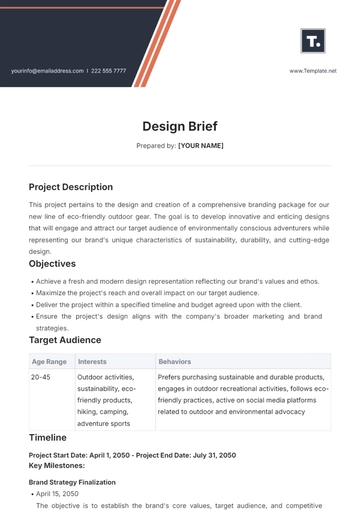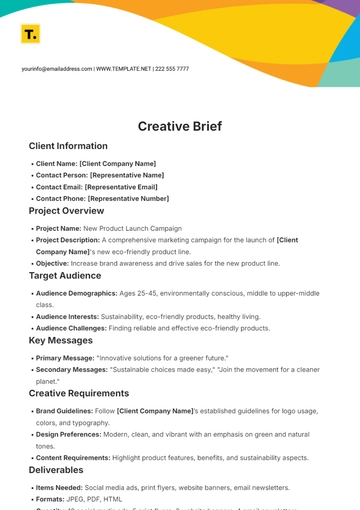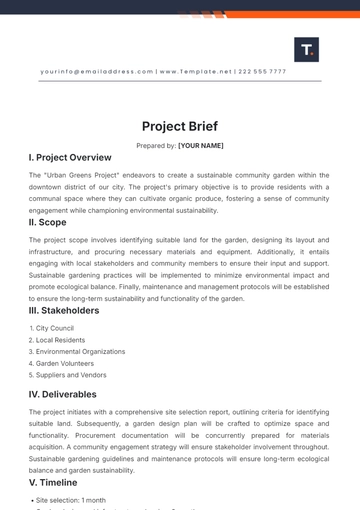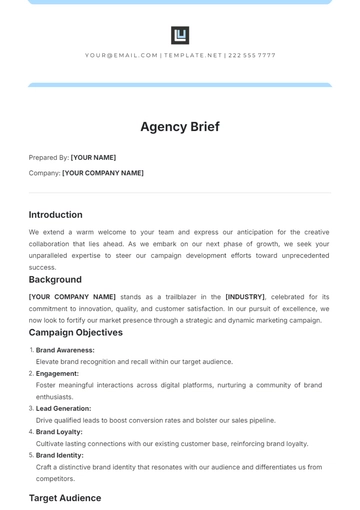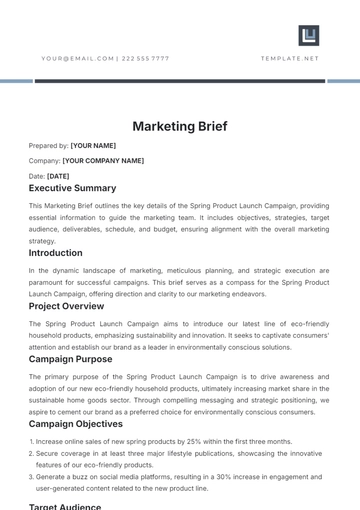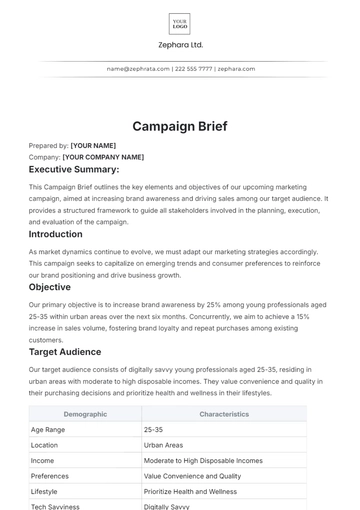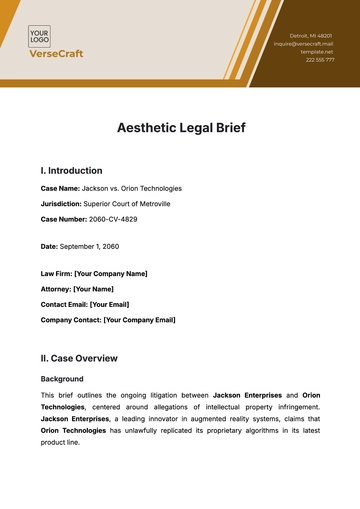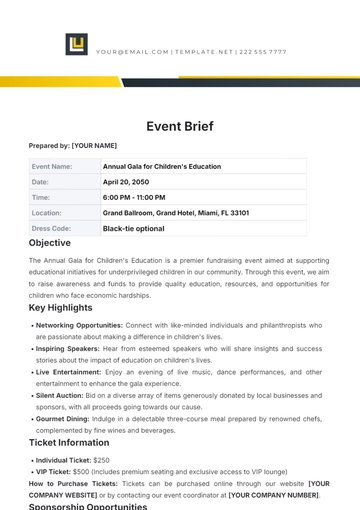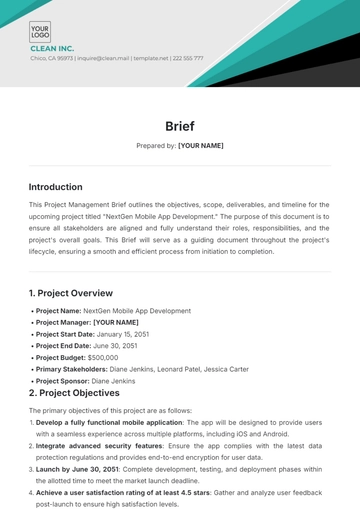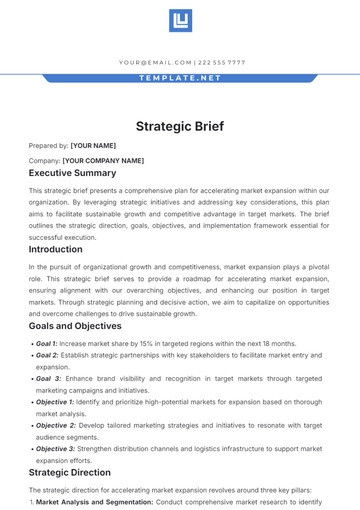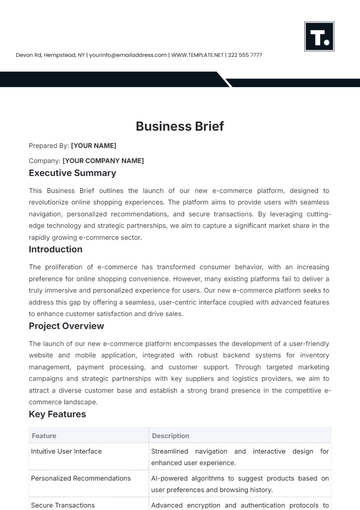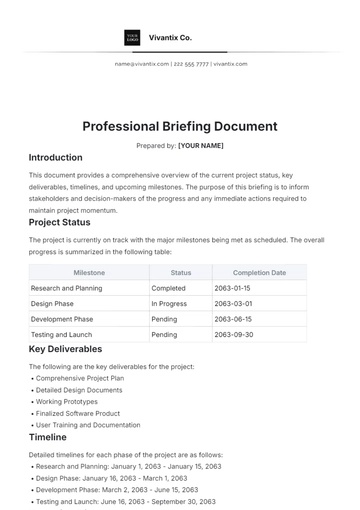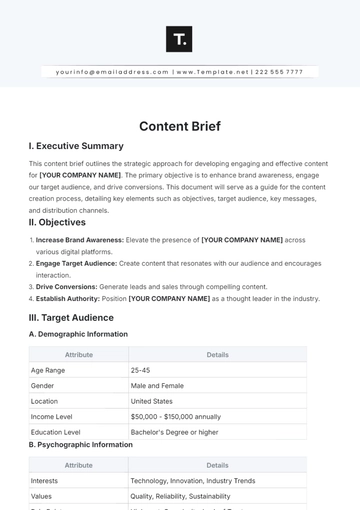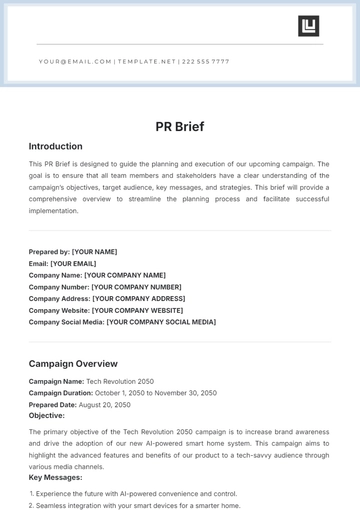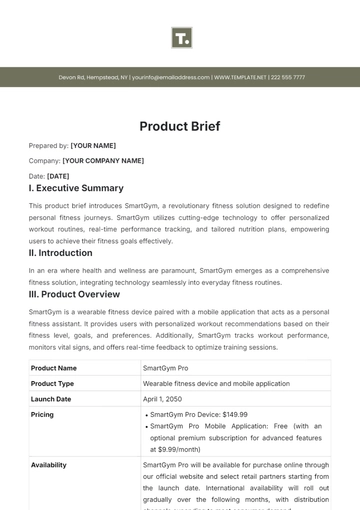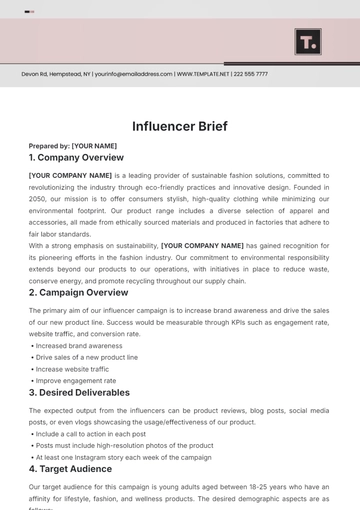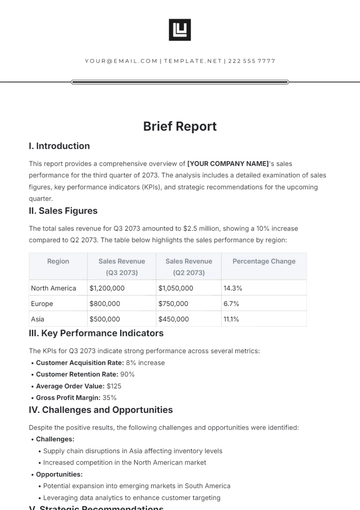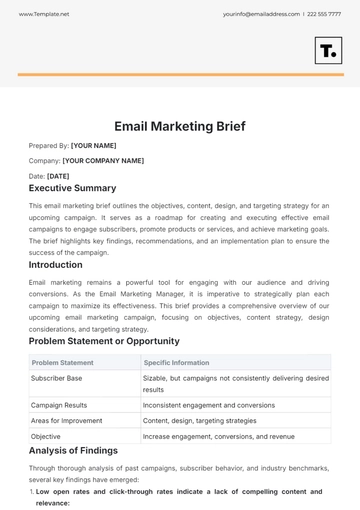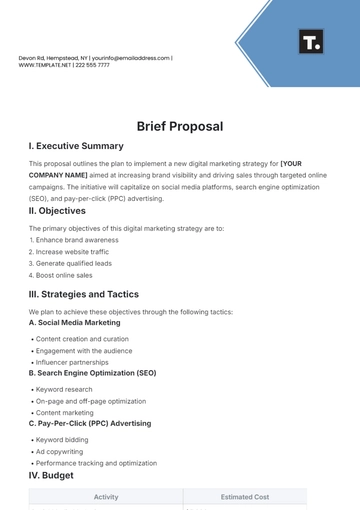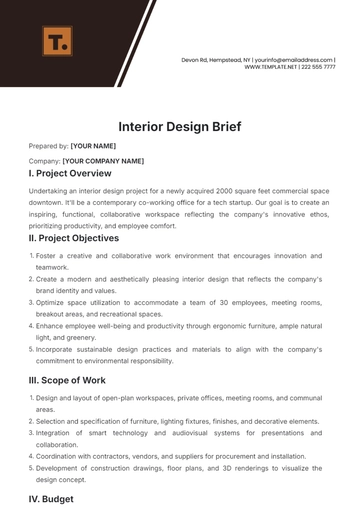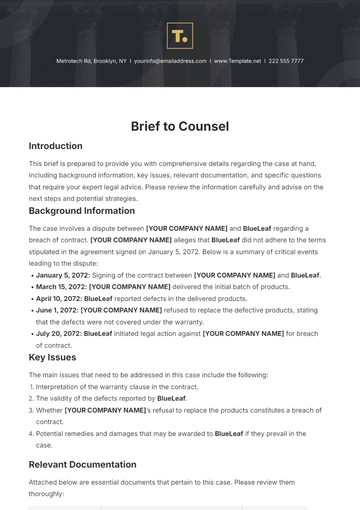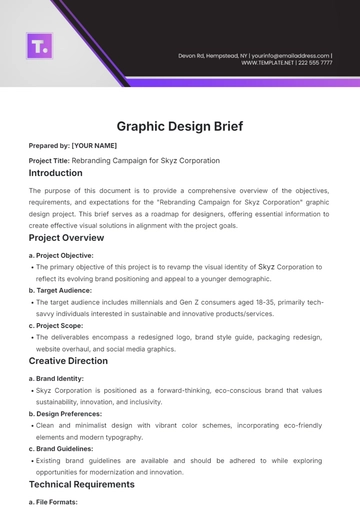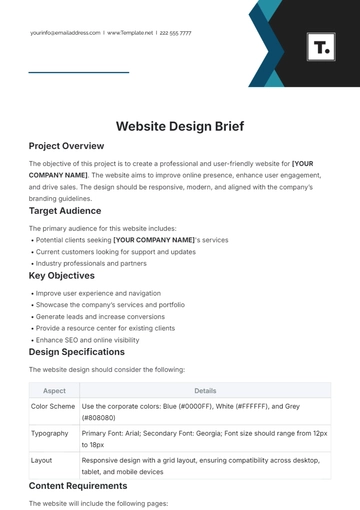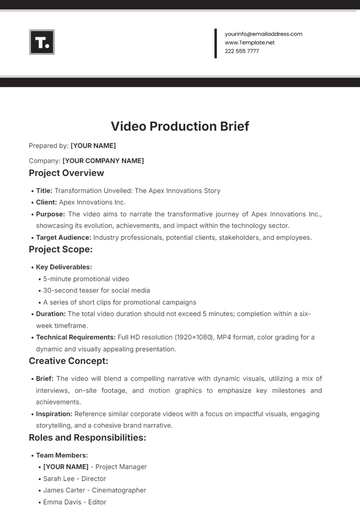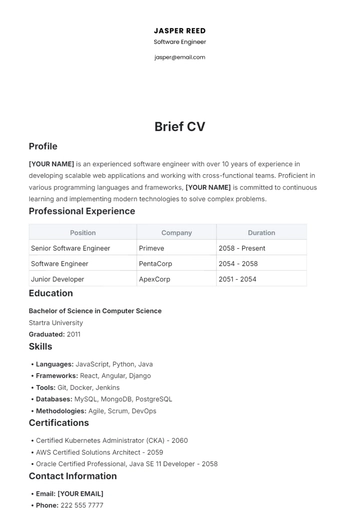Free Team Collaboration Brief
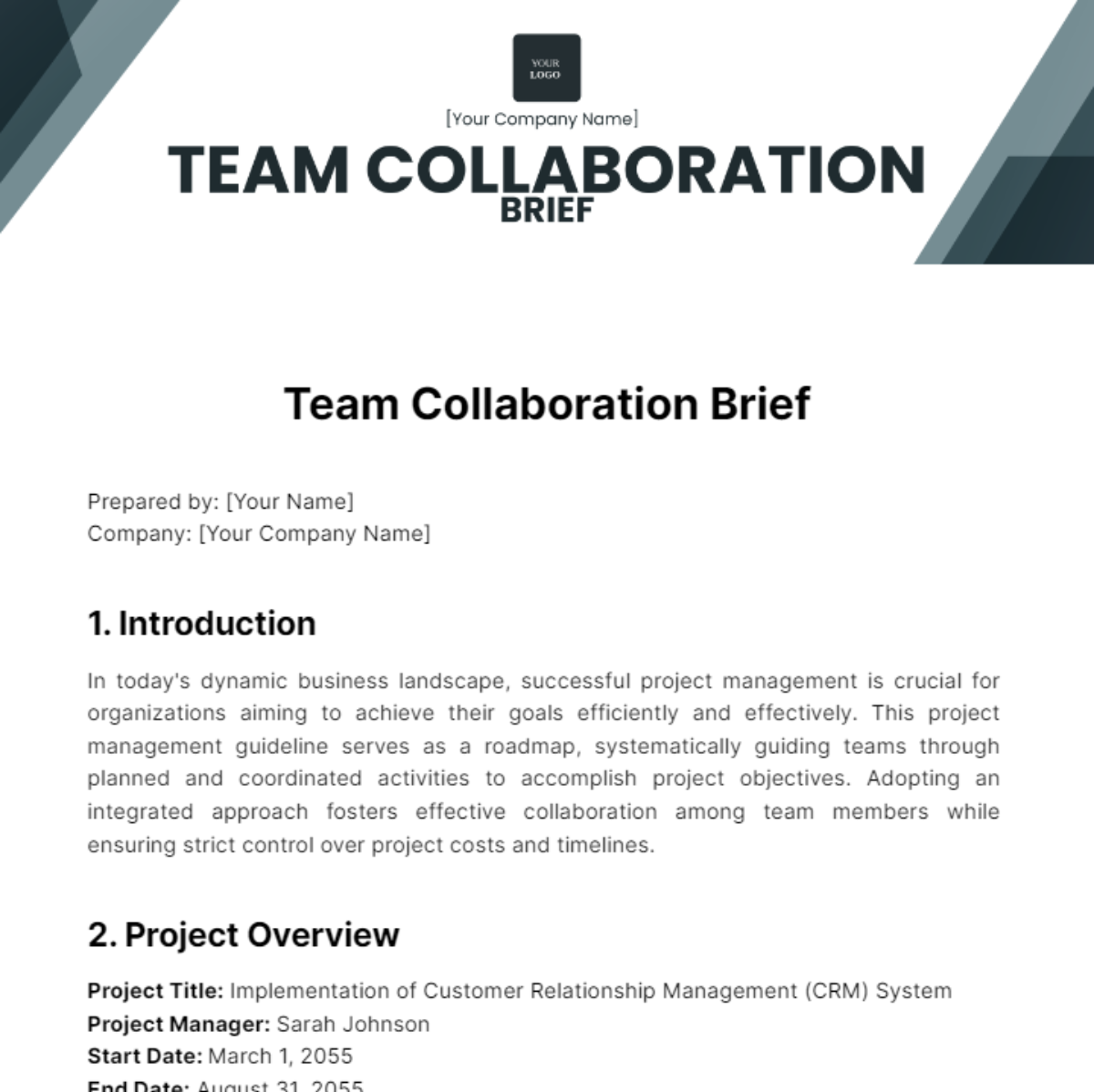
Prepared by: [Your Name]
Company: [Your Company Name]
1. Introduction
In today's dynamic business landscape, successful project management is crucial for organizations aiming to achieve their goals efficiently and effectively. This project management guideline serves as a roadmap, systematically guiding teams through planned and coordinated activities to accomplish project objectives. Adopting an integrated approach fosters effective collaboration among team members while ensuring strict control over project costs and timelines.
2. Project Overview
Project Title: Implementation of Customer Relationship Management (CRM) System
Project Manager: Sarah Johnson
Start Date: March 1, 2055
End Date: August 31, 2055
Project Objectives:
Implement a fully functional CRM system to streamline customer interactions and improve customer satisfaction.
Integrate the CRM system with existing sales and marketing platforms to enhance lead management and customer segmentation.
Train employees on effectively using the CRM system to maximize its benefits and improve productivity.
Project Description:
The Implementation of Customer Relationship Management (CRM) System project aims to enhance customer relationship management practices within the organization. By implementing a CRM system, we seek to centralize customer data, streamline communication processes, and improve overall customer experience. This project aligns with the organization's strategic goal of improving operational efficiency and fostering long-term customer relationships.
Scope of Work:
The project scope encompasses the following tasks:
Selecting an appropriate CRM software solution.
Customizing the CRM system to meet the organization's specific needs.
Integrating the CRM system with existing sales, marketing, and customer support platforms.
Conducting training sessions for employees to ensure effective utilization of the CRM system.
Key Stakeholders:
Sarah Johnson - Project Manager
Mark Thompson - Sales Director
Emily Chen - Marketing Manager
John Davis - Customer Service Manager
Project Deliverables:
Selected CRM software vendor and implementation plan.
Customized CRM system tailored to organizational requirements.
Integrated CRM system with existing sales, marketing, and customer support platforms.
Completed employee training program on CRM system usage.
Project Risks:
Lack of user adoption:
Probability: Medium
Impact: High
Mitigation Plan: Implement a comprehensive training program and appoint internal champions to promote user adoption.
Technical challenges during implementation:
Probability: Low
Impact: Medium
Mitigation Plan: Conduct thorough testing before deployment and have technical support available during implementation.
Budget:
The project budget is $100,000, including allocations for CRM software licensing, customization, integration, training, and contingency.
Project Team:
Sarah Johnson - Project Manager
Role: Overall project coordination, stakeholder communication, and resource management.
Mark Thompson - Sales Director
Role: Provide input on CRM system requirements and ensure alignment with sales objectives.
Emily Chen - Marketing Manager
Role: Provide input on CRM system requirements and ensure alignment with marketing objectives.
John Davis - Customer Service Manager
Role: Provide input on CRM system requirements and ensure alignment with customer service objectives.
The Implementation of the Customer Relationship Management (CRM) System project is poised to revolutionize our customer relationship management practices and drive business growth. With careful planning, effective execution, and proactive risk management, we are confident in our ability to deliver a successful CRM implementation that enhances customer satisfaction and contributes to our organization's success.
Project Objectives
Implement a fully functional Customer Relationship Management (CRM) system: The primary objective is to deploy a robust CRM system that centralizes customer data, streamlines communication channels, and facilitates efficient interaction tracking. This system should enhance customer service, improve sales processes, and strengthen customer relationships.
Integrate the CRM system with existing business platforms: This objective involves seamlessly integrating the CRM system with existing sales, marketing, and customer service platforms. By ensuring compatibility and data synchronization across systems, the organization can achieve a unified view of customer interactions and improve decision-making processes.
Enhance lead management and customer segmentation: The project aims to optimize lead management processes by leveraging the CRM system's capabilities for lead tracking, scoring, and prioritization. Additionally, it seeks to enhance customer segmentation strategies by utilizing the CRM's data analysis features to identify and target specific customer segments effectively.
Provide comprehensive training on CRM system usage: To maximize the benefits of the CRM system, it is crucial to ensure that all relevant stakeholders are proficient in its usage. This objective involves developing and delivering comprehensive training programs tailored to different user roles within the organization. By empowering employees with the necessary skills and knowledge, the organization can drive widespread adoption of the CRM system and realize its full potential.
Improve operational efficiency and productivity: The overarching objective of the project is to enhance operational efficiency and productivity across departments by implementing a CRM system that automates routine tasks, standardizes processes, and provides actionable insights. By streamlining workflows and reducing manual effort, the organization can allocate resources more effectively and focus on value-added activities that drive business growth.
Ensure data security and compliance: As part of the CRM implementation, it is essential to prioritize data security and compliance with relevant regulations, such as GDPR or CCPA. This objective involves implementing robust security measures to safeguard customer data, ensuring data integrity and confidentiality, and adhering to regulatory requirements to mitigate the risk of data breaches or compliance violations.
By achieving these objectives, the organization can transform its customer relationship management practices, drive revenue growth, and gain a competitive edge in the market.
Roles and Responsibilities
Project Manager (Sarah Johnson):
Overall project coordination and management.
Develop project plans, timelines, and budgets.
Coordinate communication between team members, stakeholders, and management.
Monitor project progress and ensure adherence to timelines and budgets.
Identify and mitigate project risks.
Serve as the primary point of contact for project-related inquiries and issues.
Sales Director (Mark Thompson):
Provide input on CRM system requirements based on sales team needs.
Collaborate with the project manager and IT team to ensure alignment of CRM implementation with sales objectives.
Assist in data migration from existing sales systems to the new CRM platform.
Train sales team members on CRM system usage and best practices.
Monitor sales performance metrics post-implementation and provide feedback for system optimization.
Marketing Manager (Emily Chen):
Provide input on CRM system requirements based on marketing team needs.
Collaborate with the project manager and IT team to ensure alignment of CRM implementation with marketing objectives.
Assist in configuring the CRM system for marketing automation, lead tracking, and campaign management.
Train marketing team members on CRM system usage and integration with marketing tools.
Analyze marketing data collected through the CRM system to optimize campaigns and improve ROI.
Customer Service Manager (John Davis):
Provide input on CRM system requirements based on customer service team needs.
Collaborate with the project manager and IT team to ensure alignment of CRM implementation with customer service objectives.
Assist in configuring the CRM system for case management, ticketing, and customer communication.
Train customer service team members on CRM system usage and customer interaction tracking.
Monitor customer service KPIs post-implementation and provide feedback for system refinement.
IT Administrator (Tom Roberts):
Install and configure the CRM software according to specifications provided by the project manager and departmental stakeholders.
Ensure data integrity and security within the CRM system, including user access controls and data encryption.
Conduct system testing to identify and resolve any technical issues or compatibility issues.
Provide technical support and troubleshooting assistance to users during and after the CRM implementation.
Collaborate with external vendors or consultants as needed for specialized technical tasks or system integrations.
Training Coordinator (Lucy Williams):
Develop training materials and resources for CRM system users based on their respective roles and responsibilities.
Coordinate training sessions for employees across departments, ensuring comprehensive coverage of CRM functionalities.
Facilitate hands-on training workshops and provide ongoing support to users as they familiarize themselves with the CRM system.
Collect feedback from trainees to identify areas for improvement in training materials or delivery methods.
Collaborate with departmental managers to schedule training sessions at convenient times and locations for employees.
By clearly defining roles and responsibilities, each team member can contribute effectively to the CRM implementation project, ensuring its success and maximizing its benefits for the organization.
Scope of the Project
The scope of the Customer Relationship Management (CRM) System Implementation project encompasses the following key components:
System Selection and Procurement:
Conducting market research to identify suitable CRM software vendors.
Evaluating vendor proposals and selecting the CRM solution that best aligns with the organization's requirements and budget.
Negotiating contract terms and finalizing procurement agreements.
System Configuration and Customization:
Collaborating with the selected CRM software vendor to configure the system according to the organization's specific needs and workflows.
Customizing the CRM system to accommodate unique business processes, data fields, and user roles.
Integrating the CRM system with existing business applications, such as sales, marketing, and customer service platforms.
Data Migration and Clean-up:
Assessing existing data sources and determining the data migration strategy.
Extracting, transforming, and loading (ETL) data from legacy systems into the new CRM platform.
Cleaning and deduplicating data to ensure accuracy and consistency within the CRM system.
Conducting data validation and reconciliation to verify the integrity of migrated data.
Training and User Adoption:
Developing comprehensive training materials and resources tailored to different user roles and skill levels.
Conducting training sessions for employees across departments to familiarize them with the CRM system's features and functionalities.
Providing ongoing support and guidance to users as they navigate the CRM system and incorporate it into their daily workflows.
Monitoring user adoption rates and addressing any challenges or concerns raised by employees.
System Testing and Quality Assurance:
Creating test cases and scenarios to validate the functionality, performance, and usability of the CRM system.
Conducting various types of testing, including functional testing, integration testing, and user acceptance testing.
Identifying and resolving any defects or issues uncovered during the testing phase.
Ensuring that the CRM system meets predefined quality standards and performance metrics before deployment.
Go-live and Deployment:
Planning and coordinating the go-live process to minimize disruption to business operations.
Conducting final data migration and validation checks before transitioning to the new CRM system.
Communicating with stakeholders and end-users to inform them of the system's launch and provide support during the transition period.
Monitoring system performance and addressing any post-deployment issues or concerns promptly.
Post-implementation Support and Optimization:
Providing ongoing technical support and troubleshooting assistance to users as they continue to use the CRM system.
Collecting feedback from stakeholders and end-users to identify opportunities for system optimization and enhancement.
Iteratively improving the CRM system based on user feedback, evolving business requirements, and emerging technology trends.
Conducting regular system audits and maintenance activities to ensure long-term sustainability and effectiveness.
By defining the scope of the project upfront, stakeholders can have a clear understanding of what is included (and excluded) from the CRM implementation effort, helping to manage expectations and ensure successful project delivery.
Communication and Collaboration Guidelines
Effective communication and collaboration are essential for the success of the CRM System Implementation project. The following guidelines outline best practices to ensure clear communication, foster collaboration among team members, and promote project transparency:
Establish Communication Channels:
Set up regular project meetings, including kickoff meetings, status updates, and milestone reviews.
Use collaboration tools such as project management software, messaging platforms, and video conferencing tools to facilitate communication among team members.
Maintain an updated contact list with the names, roles, and contact information of all project stakeholders.
Define Roles and Responsibilities:
Clearly define the roles and responsibilities of each team member, including project managers, departmental leads, IT administrators, and end-users.
Ensure that everyone understands their role in the project and their contribution to its success.
Establish clear channels for reporting progress, raising concerns, and escalating issues as needed.
Provide Regular Updates:
Schedule regular status update meetings or email updates to keep stakeholders informed of project progress, milestones achieved, and any issues or risks identified.
Communicate proactively about changes in project scope, timelines, or requirements to manage expectations effectively.
Encourage open communication and transparency to foster trust and collaboration among team members.
Encourage Active Participation:
Encourage active participation and feedback from all project stakeholders, including end-users, departmental leads, and executive sponsors.
Create opportunities for team members to share their insights, ideas, and concerns during meetings, brainstorming sessions, or feedback forums.
Foster a collaborative environment where everyone feels valued and empowered to contribute to the project's success.
Document Decisions and Agreements:
Document key decisions, agreements, and action items from meetings and discussions to ensure clarity and accountability.
Use project management tools or collaboration platforms to track tasks, deadlines, and responsibilities assigned to each team member.
Circulate meeting minutes, project plans, and other relevant documentation to all stakeholders to keep everyone aligned and informed.
Resolve Conflicts Promptly:
Address conflicts or disagreements among team members promptly and constructively.
Encourage open dialogue and active listening to understand different perspectives and find mutually acceptable solutions.
Involve project managers or mediators if necessary to facilitate conflict resolution and maintain positive working relationships.
Celebrate Achievements and Milestones:
Recognize and celebrate achievements, milestones, and successful outcomes throughout the project lifecycle.
Acknowledge the contributions of individual team members and departments to motivate and inspire continued collaboration and commitment.
Organize team-building activities or social events to strengthen relationships and foster a sense of camaraderie among team members.
By following these communication and collaboration guidelines, the project team can effectively coordinate their efforts, address challenges, and work together toward achieving the goals of the CRM System Implementation project.
Risk Management
Identifying and managing risks is critical for the success of the CRM System Implementation project. The following risk management plan outlines the process for identifying, assessing, mitigating, and monitoring risks throughout the project lifecycle:
Risk Identification:
Conduct a thorough risk assessment at the beginning of the project to identify potential risks that could impact project objectives, timelines, or budget.
Engage project stakeholders, team members, and subject matter experts to identify risks related to technical, organizational, and external factors.
The document identified risks in a risk register, including their descriptions, potential impacts, the likelihood of occurrence, and priority levels.
Risk Assessment:
Evaluate each identified risk based on its likelihood of occurrence and potential impact on project objectives.
Prioritize risks according to their severity and likelihood, focusing on high-priority risks that could have a significant impact on project success.
Use qualitative and quantitative risk analysis techniques to assess and prioritize risks effectively.
Risk Mitigation Strategies:
Develop risk mitigation strategies to reduce the likelihood or impact of identified risks.
Implement preventive measures to address risks proactively before they occur, such as implementing robust data backup procedures, conducting thorough testing, or establishing contingency plans.
Assign responsibilities for implementing risk mitigation strategies to relevant team members or stakeholders.
Develop contingency plans for high-priority risks that cannot be fully mitigated, outlining alternative approaches or actions to minimize their impact if they occur.
Risk Monitoring and Control:
Regularly monitor identified risks throughout the project lifecycle to track changes in their likelihood or impact.
Implement risk control measures to address emerging risks or changes in risk factors promptly.
Review and update the risk register regularly to reflect changes in risk status, mitigation strategies, or new risks identified.
Communicate risk status and updates to project stakeholders, ensuring transparency and awareness of potential threats to project success.
Conduct periodic risk reviews and assessments to evaluate the effectiveness of risk mitigation strategies and identify any new risks that may arise.
Contingency Planning:
Develop contingency plans for critical project risks, outlining alternative courses of action to be taken if those risks materialize.
Identify trigger points or indicators that signal when contingency plans should be activated.
Ensure that contingency plans are documented, communicated to relevant stakeholders, and readily available in case they need to be executed.
Regularly review and update contingency plans as needed based on changes in project circumstances or risk factors.
By implementing this risk management plan, the project team can proactively identify, assess, and mitigate risks, minimizing the potential impact on project success and ensuring the successful delivery of the CRM System Implementation project.
Conclusion
The successful implementation of the Customer Relationship Management (CRM) System project will significantly enhance our organization's ability to streamline customer interactions, improve operational efficiency, and drive business growth. By adopting a systematic approach to project management, prioritizing effective communication and collaboration, and proactively managing risks, we are well-positioned to achieve our project objectives and deliver tangible benefits to the organization.
Throughout the project lifecycle, we will remain committed to:
Ensuring alignment with organizational goals and objectives, and continuously monitoring progress to stay on track.
Fostering open communication and collaboration among project team members, stakeholders, and end-users to facilitate knowledge sharing and problem-solving.
Adapting to changing requirements and market dynamics by leveraging agile methodologies and maintaining flexibility in our approach.
Prioritizing quality and customer satisfaction by implementing rigorous testing, providing comprehensive training, and delivering a user-friendly CRM system that meets the needs of our stakeholders.
Proactively identifying and mitigating risks to minimize disruptions and ensure project success.
As we embark on this journey, we are confident in our collective abilities to overcome challenges, capitalize on opportunities, and deliver a CRM system that transforms our customer relationship management practices and drives sustainable growth for our organization.
Together, we will not only achieve our project goals but also lay the foundation for continued success and innovation in the future.
Thank you to all team members, stakeholders, and partners for your dedication, support, and contributions to the CRM System Implementation project. Your commitment and collaboration are instrumental in our journey toward success.
Let us move forward with confidence, determination, and a shared vision of excellence.
- 100% Customizable, free editor
- Access 1 Million+ Templates, photo’s & graphics
- Download or share as a template
- Click and replace photos, graphics, text, backgrounds
- Resize, crop, AI write & more
- Access advanced editor
Introducing the Team Collaboration Brief Template from Template.net – your essential tool for fostering efficient teamwork and synergy. Customizable and editable, it simplifies outlining collaboration objectives, roles, and communication channels. Seamlessly editable in our Ai Editor Tool, ensuring precision and clarity in every detail. Elevate your team collaboration efforts with this template crafted to streamline organization and enhance productivity.
